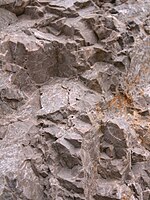
Photo from wikipedia
Abstract Precipitation of calcium carbonate crystals caused by the metabolic activities of certain microorganisms is a relatively new method which can improve the properties of concrete and repair concrete cracks.… Click to show full abstract
Abstract Precipitation of calcium carbonate crystals caused by the metabolic activities of certain microorganisms is a relatively new method which can improve the properties of concrete and repair concrete cracks. The present study investigated the effects of Sporosarcina pasteurii bacteria on healing cracks, compressive strength, tensile strength, ultrasonic pulse velocity, electrical resistivity and microstructure of concrete containing various percentages of limestone powder and natural zeolite. Experimental results show that the microbial calcite precipitations enhanced compressive strength, tensile strength, ultrasonic pulse velocity and electrical resistivity of all specimens at all ages. The maximum values of these parameters are related to the bacterial specimen containing 10% zeolite without limestone powder. The SEM images of the specimens show that the amount of calcite crystals in the bacterial treated specimen containing limestone powder is more than the specimen without that. In addition, crack healing of the specimen containing limestone powder was also slightly better than the specimen without that. The results of Fourier-Transform Infrared spectroscopy show that the precipitation formed at crack surfaces of specimens is CaCO3.
Journal Title: Construction and Building Materials
Year Published: 2020
Link to full text (if available)
Share on Social Media: Sign Up to like & get
recommendations!